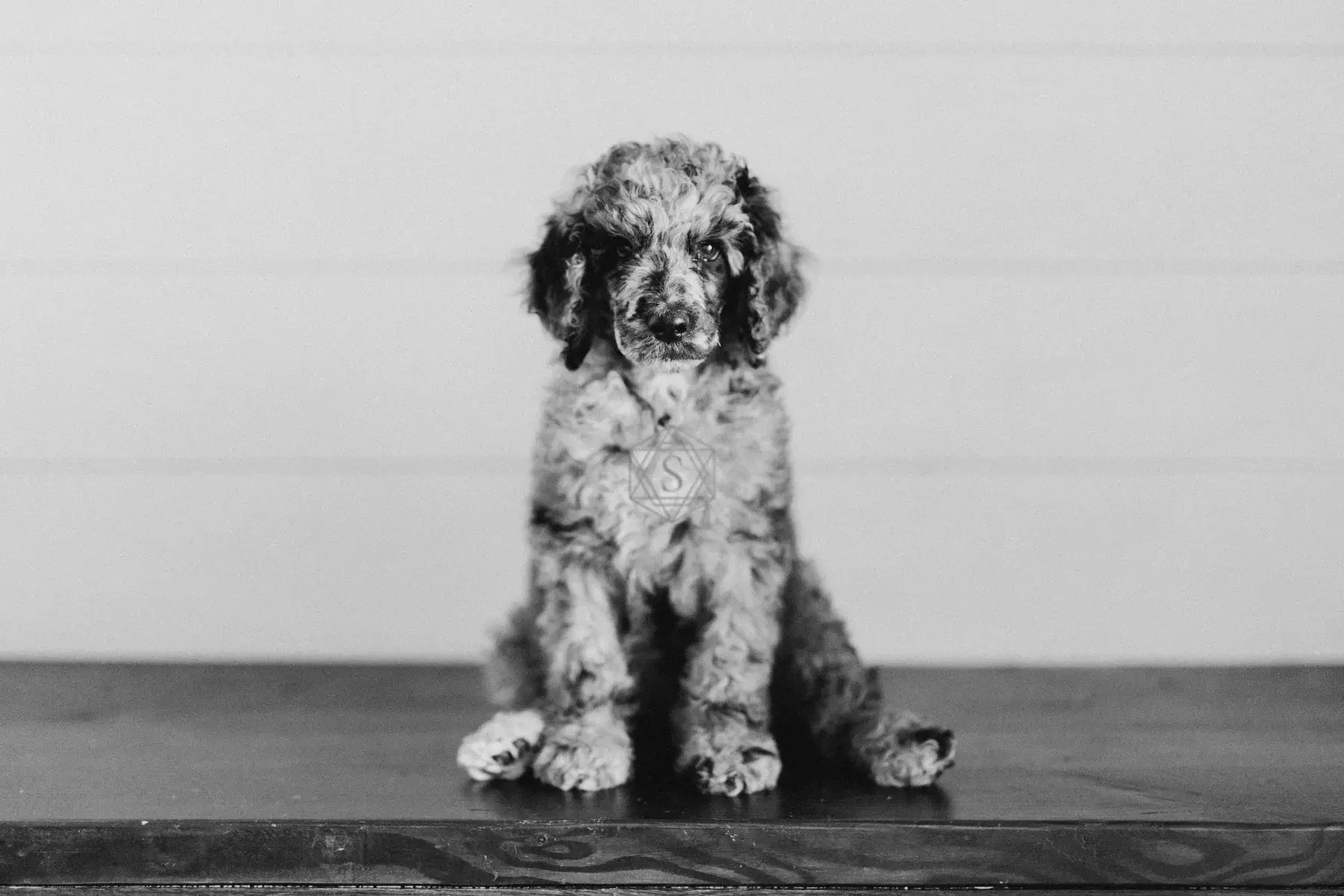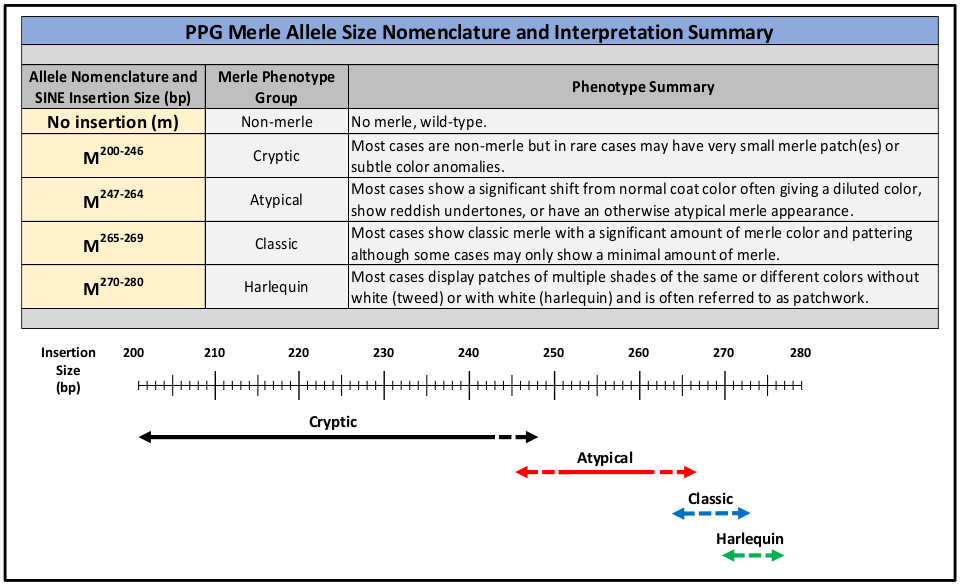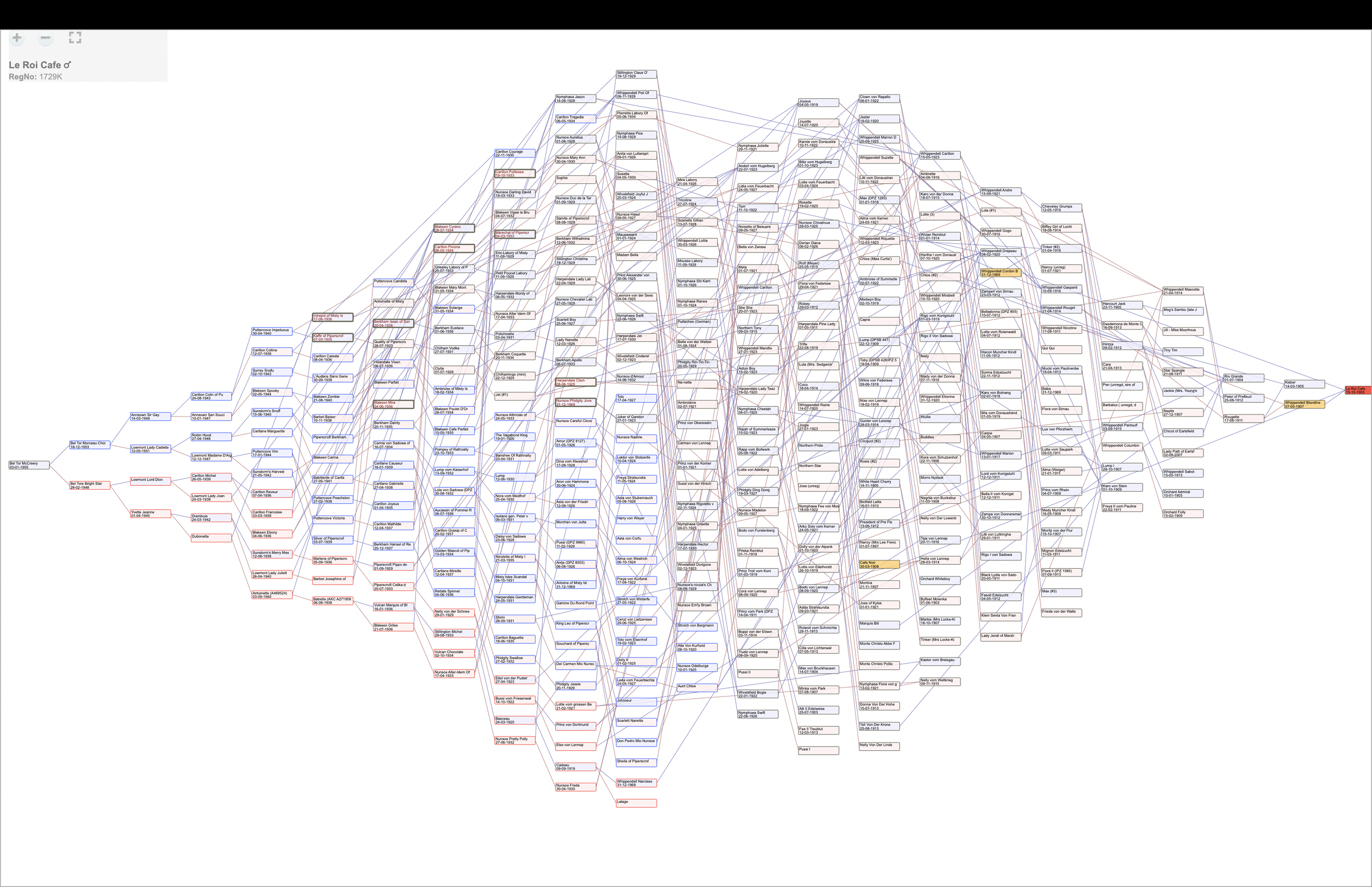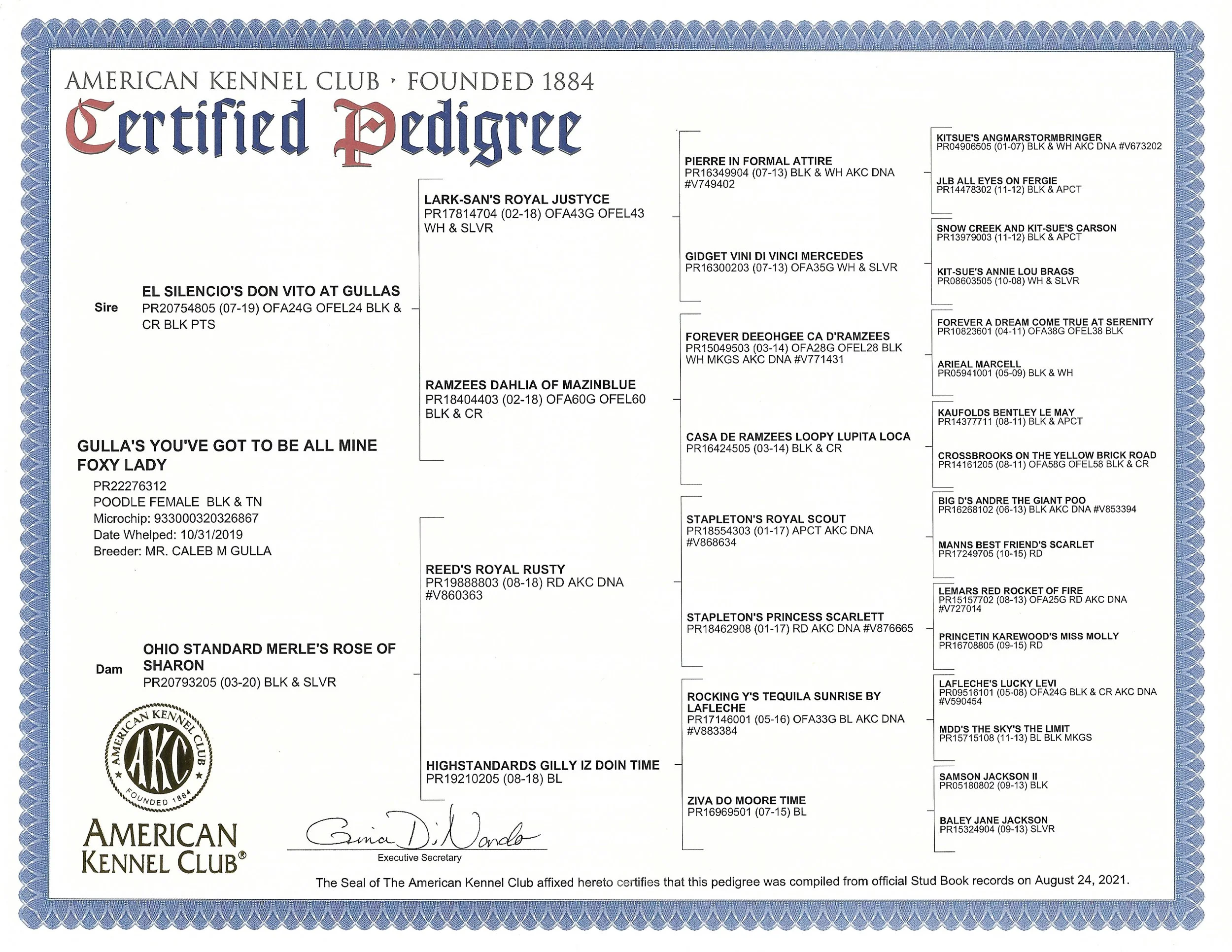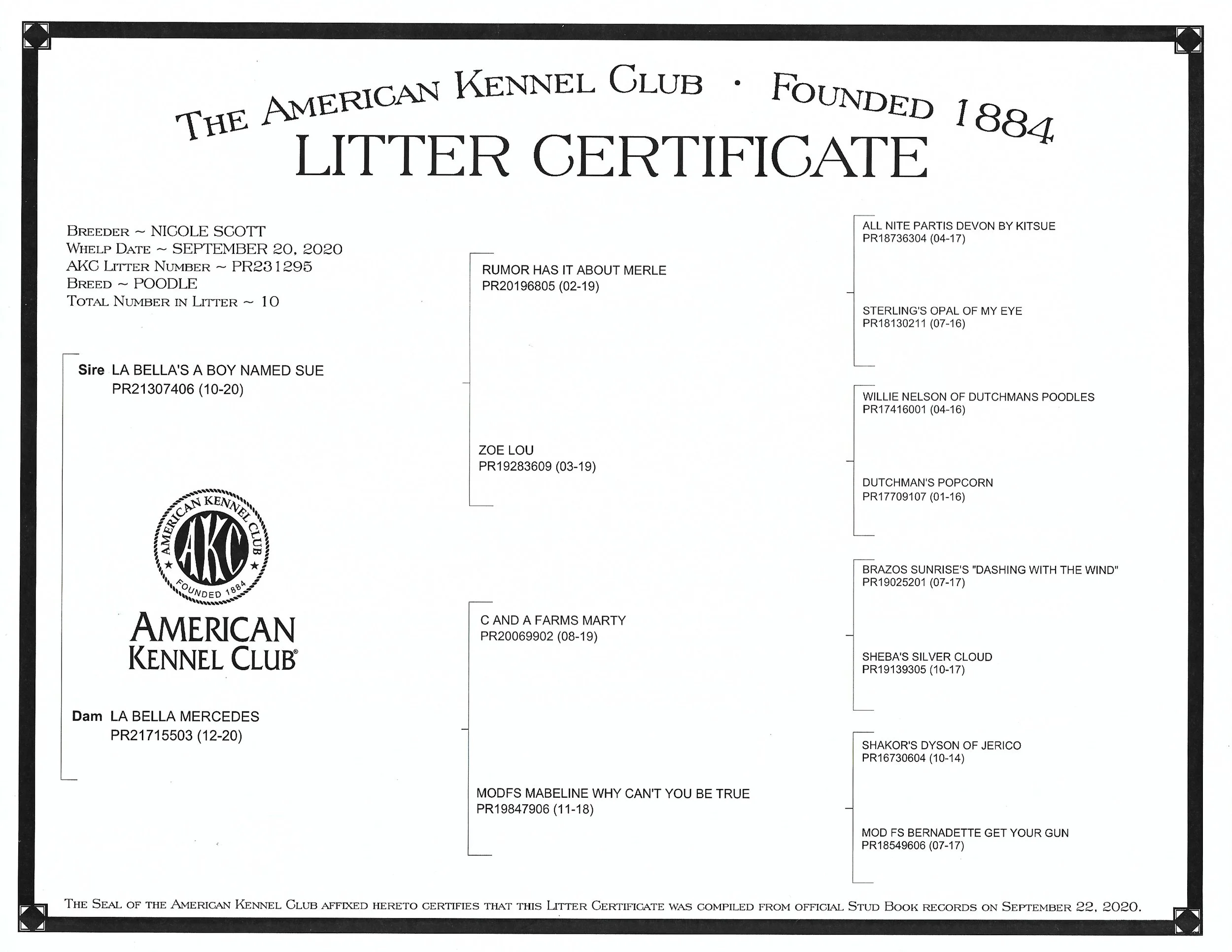Merle Coat Coloration in Poodles and “Doodles”: A Historical and Genetic Overview
Abstract
The merle coat coloration, caused by a retrotransposon insertion in the PMEL (also called SILV) gene, is well-established across multiple dog breeds. Historically, Standard Poodles were not recognized as having the merle pattern, and the appearance of merle in Poodles has raised questions about its origin. In designer crossbreeds such as “Doodles,” which involve Poodles crossed with other breeds, the merle phenotype has become increasingly popular. This paper explores the genetic basis of merle, reviews the history of merle-like coloration in Poodles, and discusses its adoption in modern designer crosses, highlighting ongoing debates over authenticity and breed purity.
Introduction
Coat color genetics in dogs has garnered significant scientific attention due to its complexity and implications for breeding practices. Among the various coat color loci, the merle phenotype stands out for its striking pattern, typically featuring a mottled or dappled mixture of colored and diluted patches (Clark, Wahl, Rees, & Murphy, 2006). While well-documented in herding breeds (e.g., Australian Shepherds, Collies), the merle pattern has also been reported—albeit controversially—among Poodles and Poodle-derived crossbreeds (“Doodles”) (Murphy et al., 2018).
The purpose of this article is to (a) discuss the genetic basis of merle coloration, (b) trace the history and controversy surrounding merle in purebred Poodles, and (c) elaborate on the emergence of merle in Poodle crossbreeds, particularly “Doodles.”
Genetic Basis of Merle
The PMEL/SILV Gene and Retrotransposon Insertion
Merle is caused by an insertion in the PMEL (also known as SILV) gene (Clark et al., 2006). The insertion is classified based on its length, with different size ranges sometimes denoted as Mc, Ma, M, and Mh (Murphy et al., 2018; Ballif et al., 2018; Langevin et al., 2018). Phenotypically, these alleles can produce varying degrees of merle expression, from subtle patching to extensive dilution.
Historically, Clark et al. (2006) were among the first to describe how merle results from this retrotransposon insertion. Since then, other researchers have refined allele classification to better correlate with observable patterns (Murphy et al., 2018; Langevin et al., 2018).
Interaction with Other Loci (e.g., Harlequin in Great Danes)
It is crucial to differentiate the merle locus from other coat modifiers such as the Harlequin locus (H) found in Great Danes. The “Mh” allele in some merle classifications, often called “harlequin-merle,” should not be confused with the classical Harlequin gene, which is a separate locus entirely (Clark, Starr, Tsai, & Murphy, 2008; Langevin et al., 2018).
Historical Context of Merle in Poodles
Traditional Poodle Color Spectrum
Purebred Poodles (Standard, Miniature, and Toy) have been documented in a variety of solid coat colors (black, white, brown, gray, apricot, etc.) as well as patterned coats (e.g., parti-color, phantom) that do not involve the merle gene (American Kennel Club [AKC], n.d.). Historically, merle was not recognized in the Poodle breed standards (AKC, n.d.).
Appearance of Merle in the Poodle Gene Pool
Beginning in the late 20th century, scattered reports emerged of Poodles displaying a merle-like pattern (Orth & Spangler, 2019). The origin of these merle Poodles remains disputed, with some breeders suggesting that a genetic mutation spontaneously appeared, while others propose outcrossing to merle-carrying breeds introduced the merle locus into certain Poodle lines (Murphy et al., 2018).
While direct scientific studies specifically on merle in Poodles are limited, anecdotal evidence and preliminary genetic tests have shown that merle in these lines appears consistent with the same PMEL/SILV insertion found in established merle breeds (Ballif et al., 2018). Critics argue that the presence of merle in “pure” Poodles is likely due to unrecorded crossbreeding (Orth & Spangler, 2019).
Merle in Doodles: Expansion and Popularity
The Rise of Designer Crosses
“Doodles,” crossbred dogs combining a Poodle with another breed—most famously, the Labrador Retriever (“Labradoodle”) or Golden Retriever (“Goldendoodle”)—have gained significant popularity for their hypoallergenic qualities and diverse coat patterns (Rohner & Giger, 2021).
Introduction of the Merle Gene through Crossbreeding
Merle can easily be introduced into Poodle crosses when the non-Poodle breed parent is merle-carrying (e.g., Australian Shepherd, Border Collie) (Ballif et al., 2018). As demand for unique and visually striking coat patterns increases, breeders may selectively incorporate merle-carrying individuals into their Poodle cross programs (Rohner & Giger, 2021).
Genetic testing laboratories often report the PMEL allele length for “Doodle” puppies, providing a classification (e.g., Mc, Ma, M, Mh) alongside coat color predictions (Murphy et al., 2018). However, because different authors and laboratories use different cutoffs for these allele-length categories, confusion can arise if the consumer or veterinarian is unaware of the lab’s specific classification system (Langevin et al., 2018).
Ongoing Debates and Considerations
Breed Purity
Traditional breed registries, such as the AKC, do not recognize merle as an acceptable color in Poodles. This discrepancy often leads to debates on purity, with many breeders questioning the legitimacy of Merle Poodles (Orth & Spangler, 2019).Health Implications
Homozygosity for the merle allele (M/M) is associated with auditory and ocular anomalies (Clark et al., 2006; Murphy et al., 2018). Breeders introducing merle into new populations must carefully monitor matings to avoid doubling up on the merle allele, which can lead to an increased risk of deafness or eye defects.Genetic Testing and Responsible Breeding
Genetic testing via polymerase chain reaction (PCR) fragment analysis or other molecular techniques allows breeders to confirm merle status before breeding (Clark et al., 2006; Langevin et al., 2018). This can help minimize health risks and clarify genealogical confusion regarding merle Poodles and Doodles.
The Basic Math: Percentage of Ancestry in Each Generation
How Percentages Decrease with Each Breeding
When a crossbred dog (with some percentage of “non-Poodle” ancestry) is bred back to a 100% Poodle, the offspring’s percentage of Poodle ancestry increases, and the “non-Poodle” fraction halves with each generation.
Generation 0 (the outcross): Suppose you have a pure Poodle (100% Poodle) crossed once with another breed (0% Poodle). The immediate offspring is:
50% Poodle(½ from the Poodle parent, ½ from the other parent). 50\% \text{ Poodle} \quad\text{(½ from the Poodle parent, ½ from the other parent).}50% Poodle(½ from the Poodle parent, ½ from the other parent).
Generation 1: If that 50% Poodle is then bred back to a 100% Poodle, the offspring are on average:
75\% \text{ Poodle} \quad\text{(½ of 50% + ½ of 100%).}
Generation 2: Bred again to a 100% Poodle:
87.5% Poodle. 87.5\% \text{ Poodle}.87.5% Poodle.
Generation 3:
93.75% Poodle. 93.75\% \text{ Poodle}.93.75% Poodle.
And so on. In general, if you start at 50% Poodle and keep crossing back to 100% Poodle, after NNN backcross generations:
%Poodle=100%−50%×(12)N\% \text{Poodle} = 100\% - 50\% \times \left(\frac{1}{2}\right)^N %Poodle=100%−50%×(21)N
(or more simply, 1−12N+11 - \frac{1}{2^{N+1}}1−2N+11 if you look at the fraction directly).
Generational Timescales (1.5–2 Years per Generation)
If you assume 1.5 to 2 years per generation:
In 15 years, a line might have ~10 generations (if 1.5 years/generation).
In 20 years, a line might have ~10 generations (if 2 years/generation), or up to 13 or so if you push generation times on the lower end.
After 10 generations of backcrossing:
%Poodle=100%−50%×(12)10=100%−50%×11024≈100%−0.0488%≈99.95% Poodle.\% \text{Poodle} = 100\% - 50\% \times \left(\frac{1}{2}\right)^{10} = 100\% - 50\% \times \frac{1}{1024} \approx 100\% - 0.0488\% \approx 99.95\% \text{ Poodle}.%Poodle=100%−50%×(21)10=100%−50%×10241≈100%−0.0488%≈99.95% Poodle.
That means, mathematically, in just 10 generations (which could be only 15–20 years, depending on breeding practices), the “non-Poodle” DNA fraction may drop below 0.1%.
Why Not All Poodles Descend from a Single Outcross
Multiple Founding Lines
Even if a single outcross did happen in a particular kennel or lineage, not all Poodles around the world (or even within a large country) necessarily share that outcross. Different Poodle lines evolve in parallel:
Historically, various kennels imported or maintained different breeding stock.
Not every kennel used or had access to the same stud dogs or dams.
The breed existed in many regions with minimal overlap for long stretches of time.
Hence, it’s improbable that one outcross “took over” every single line—unless that line was so influential that it replaced nearly all breeding stock (a “sweep” scenario, which is typically documented and rare).
Founder Effects vs. Multiple Lineages
“Founder effects” describe how a limited number of ancestors can shape a large percentage of a breed’s gene pool. But in real-world breeding practices, multiple different founding lines exist. Some lines may have introduced new genetic diversity at different times, and many lines never intermingled. Therefore, attributing all modern Poodles to just one outcross event is extremely unlikely.
Pinpointing if and When an Outcross Happened
Pedigree Documentation
Historically, precise pedigree records (e.g., kennel club registrations) are the most straightforward way to pinpoint an outcross:
Written records: If breeders meticulously recorded each litter’s sire and dam, outcross events would be documented—even if it was decades ago.
Kennel club or breeder logs: Sometimes show an unusual name from a different breed or a “foundation bitch” whose ancestry is not fully Poodle.
Modern Genetic Testing
If historical records are incomplete, the only way to “catch” an old outcross would be through in-depth DNA analysis:
Genome-wide SNP arrays or whole-genome sequencing can detect segments that do not match typical Poodle haplotypes.
Length of “foreign” segments shrinks each generation due to recombination—but advanced methods can estimate how many generations ago an outcross happened based on the size, distribution, and frequency of these distinct segments.
However, if many generations have passed (e.g., 10+ generations) and the outcross fraction is below 1%, locating that outcross’s exact date can be very challenging, especially if there’s also ongoing gene flow among multiple lines.
Confounding Factors
Multiple outcrosses in separate lines can blur the signal.
Popular sires (inbreeding around a few stud dogs) can overshadow a small trace of outcross DNA.
Thus, pinpointing a single historical outcross to one or two specific dogs in a large population is only possible if:
You have robust pedigree records and/or
Genetic data still contain unique markers traceable to that one outcross.
Summary
Mathematics of Dilution
A dog that started at 50% Poodle can become effectively >99% Poodle within ~10 generations of consistent backcrossing to pure Poodles. At 1.5–2 years per generation, that might occur in just 15–20 years.Not All Poodles from One Outcross
Even if a single outcross happened in a well-known kennel, it does not necessarily permeate the entire breed. Poodles have multiple foundational lines, making a total “takeover” by one outcross event highly unlikely.Pinpointing the Outcross
Pedigree: Historical records can reveal the crossing event.
DNA Testing: Genome-wide analyses may detect stray segments, but after many generations, these small “foreign” segments may be very difficult to identify precisely.
Thus, mathematically, a single outcross could contribute an almost negligible fraction of non-Poodle DNA after enough generations—yet that does not mean every Poodle line is derived from that event. Breeding records (or advanced genetic tools) are necessary to confirm if, when, and where an ancient outcross might have occurred.
Merle Poodles likely arose in the late 1990s or early 2000s, attributed to at least one (and possibly multiple) outcrosses with a merle-carrying breed. Since Merle did not exist historically in Poodles, there is no evidence of this pattern in foundational Poodle lines or older kennel records. Documentation increased in the early 2000s, coinciding with online breeder forums and genetic testing.
How Could a Single Outcross Introduce Merle?
Initial Outcross
If one breeder decided to cross a Poodle (0% merle) with a merle-carrying breed (e.g., Australian Shepherd) to produce a merle offspring (50% Poodle, 50% merle-carrying breed).
Merle is a dominant trait, meaning if the puppy inherits the merle allele (M) from one parent, it will express merle.
Backcrossing to Poodles
That merle offspring could then be bred back to pure (non-merle) Poodles for multiple generations.
Over several generations of consistent backcrossing to Poodles (with no new outcrosses), the percentage of “other breed” DNA rapidly diminishes, but the dominant merle gene can remain.
Dispersal Through Popular Sires/Dams
If that line produced particularly popular studs or dams (e.g., due to unique coat coloration or strong marketing), merle could spread widely.
Each generation can pass along that merle allele; within 10–15 years, dozens or even hundreds of merle Poodles might trace back to that single founder if the line was in high demand.
Thus, a “one-time” introduction could theoretically be enough to launch the merle pattern into a breed. But when did it happen and who did it?
Why It Is Uncertain That Only One Outcross Occurred
Absence of Documentation
Records of how the merle gene first entered Poodles are largely anecdotal, scattered, or incomplete.
Breeders who conducted an outcross may not have disclosed it, making it difficult to pin down a single, solitary event.
Multiple Possible Sources
Since many merle-carrying breeds exist (Australian Shepherd, Border Collie, Dachshund, Shetland Sheepdog, etc.), it is plausible there were several separate outcross incidents in different places, each independently producing merle Poodles or Poodle-crosses.
Parallel “Designer Dog” Trends
Merle soared in popularity in designer dog markets (e.g., Aussiedoodles).
Some breeders may have capitalized on marketing merle patterns by performing multiple outcrosses to meet demand.
Geographic and Temporal Gaps
Merle Poodles or Poodle-crosses showed up in different regions around the same timeframe (late 1990s–early 2000s).
This simultaneous emergence in multiple areas suggests more than one introduction event, unless there was a single popular merle stud that got shipped or sold widely.
Could That One Outcross Spread Merle to All Merle Poodles?
Even assuming one original outcross occurred, it does not necessarily imply that every modern merle Poodle can be traced back to that same dog. For “one-time” outcross DNA to spread to all merle Poodles:
High Popularity of the Founder Line
Breeders across many regions would have needed to use that line’s studs/dams extensively.
Over a decade or two, this founder’s descendants would have to dominate the Merle Poodle gene pool.
Genetic Bottleneck or “Sweep”
A gene “sweep” (where one variant becomes near-universal) often requires either extreme selection for it (i.e., breeders heavily favoring merle) or a limited population of breeders/dogs at the time.
Multiple Lines of Merle
In reality, many different merle lines likely exist—some introduced by hobby breeders, others by larger kennels.
This diversity of merle lines suggests it’s unlikely that every merle dog shares only one single ancestor, but it is possible.
One Outcross Is Theoretically Enough, But Unproven
Theoretically Feasible
Because merle is a dominant trait, only one outcross could start a line of merle-carrying Poodles if that line was then backcrossed repeatedly to pure Poodles.
Rapid expansion of that line could indeed account for a large share of today’s merle Poodles, if they all descend from a single founder.
Practically Uncertain
Due to incomplete records, anecdotal reports, and the popularity of merle in several designer crosses, it’s difficult to prove that all merle in Poodles stems from one breeding event.
Multiple outcross events at different times and places are equally (if not more) plausible.
Hence, while one single outcross could explain the presence of merle in a subset of the population, it is far from guaranteed that every merle Poodle in existence ultimately traces to that single source. In many cases, it is more likely that multiple outcrosses happened, especially given the growing demand for merle “Designer Doodles” in recent decades.
Merle in Poodles remains a contentious topic due to the historical absence of the breed standard and questions about whether the pattern was introduced through outcrossing. Regardless, the merle gene itself is well-characterized scientifically, involving a length polymorphism in the PMEL/SILV gene. As Poodle crossbreeds—such as Labradoodles and Goldendoodles—gain traction, Merle has become increasingly visible, raising both ethical and health considerations for breeders and owners. Further research, transparent breeding practices, and standardized testing approaches are vital to understanding the full impact of merle genetics in Poodles and Poodle-derived crossbreed.
The Theoretical Maximum: 221≈2,097,1522^{21} \approx 2,097,152221≈2,097,152
Exponential Growth of Ancestors
In a purely mathematical scenario with no pedigree overlap, every generation doubles the number of direct ancestors: Generation 1:2 parents;Generation 2:4 grandparents;… ;Generation 21:221≈2,097,152. \text{Generation } 1: 2 \text{ parents}; \quad \text{Generation } 2: 4 \text{ grandparents};\quad \dots;\quad \text{Generation } 21: 2^{21} \approx 2{,}097{,}152.Generation 1:2 parents;Generation 2:4 grandparents;…;Generation 21:221≈2,097,152.
This means that by the 21st generation, you could have over 2 million ancestor “slots.”
Why 21 Generations?
In dogs, a generation can be as short as 1.5–2 years (often stated in breeding contexts) or up to 3–4 years.
Even if we assume 2 years/generation, 21 generations could happen in about 42 years—feasible within the timeframe of a breeding program spanning from the late 1970s to the 2010s or 2020s.
Pedigree Collapse: The Real Number Is Fewer
Inbreeding and Repetition
In practice, real pedigrees are not made up of wholly distinct ancestors; the same dogs appear multiple times.
This phenomenon, called pedigree collapse, means the actual number of unique ancestors is far smaller than 2212^{21}221. Instead of 2 million distinct dogs, you may have many repeated names.
Founder Effects
If the breed or lineage started from only a few founders or had heavy use of specific “popular sires,” a single outcross could eventually spread widely.
When repeated breeding (line-breeding or inbreeding) amplifies certain dogs’ genetic influence, a single ancestor can appear in numerous “slots” of the pedigree.
One Dog Out of “2 Million” Could Introduce Merle
Merle as a Dominant Gene
Since merle (M) is dominant, only one copy is needed for a dog to show (or carry) merle.
In actual pedigrees, it would only take one founder that had the merle allele to begin propagating it forward. Even if on paper there are “two million ancestor slots” at 21 generations, that one merle-carrying dog can appear in repeated branches, filling many of those “slots.”
1977 Reference and Earlier Origins
Some point to 1977 as a date when merle-carrying lines (or a particular dog) emerged in Poodle pedigrees.
Given enough generations, a dog introduced in the 1970s (or possibly earlier, in lineages like Mercedes, Ramzees, Gula, or Kitsue) could account for the merle allele in a large swath of modern Poodles—through backcrossing and popular-sire effect.
Rapid Dissemination
If that merle dog (out of the “2 million” theoretical ancestors) produced popular, high-demand offspring, the allele spreads more quickly.
Over 10–20 generations, the fraction of “non-Poodle” DNA might become small, but the merle gene (being dominant) persists and shows up in offspring.
Putting It All Together
Mathematics vs. Reality
Mathematically: 21 generations → up to 2.1 million ancestor slots.
Reality: Heavy pedigree overlap means we do not see 2.1 million unique dogs—just repeated lines, often doubling back to the same ancestors.
One Dog Is Enough
Even with “2 million theoretical ancestors,” only one of those many “slots” needs to belong to a merle-carrying dog to introduce the M allele.
Once that gene is in the population and breeders select for it (or simply do not remove it), it can persist and even become common in certain lines.
Likely Earlier Than 1977
While 1977 is often cited for one known line, the gene could have been introduced earlier—perhaps in lines named Mercedes, Ramzees, Gula, or Kitsue. The exact date depends on when and where that single merle-carrying ancestor appeared.
Final Takeaway
Despite the exponential math suggesting millions of potential ancestors by the 21st generation, in real-world breeding (where pedigree collapse occurs), one dog can fill countless “slots” if it’s repeatedly used or if many lines funnel back into it. Consequently, just one merle-carrying outcross—whether in 1977 or earlier—could feasibly have introduced and propagated the merle gene throughout the Poodle population we see today.
By focusing on chromosome count and centromeres, it becomes clear that only one merle-bearing chromosome—one centromere—need come from a non-Poodle ancestor. Over dozens of generations, the dog’s genome remains overwhelmingly Poodle aside from that small region carrying the merle trait. This is why, in many registries or casual understandings of breed identity, such a dog still qualifies as “purebred,” notwithstanding the introduced coat-color gene.
References
American Kennel Club. (n.d.). Poodle (Standard) breed standard.
Retrieved from https://www.akc.org/dog-breeds/poodle-standard/
Ballif, B. C., Konar, M., Edwards, M. M., Stevens, M. R., Murphy, K. E., & Lyons, L. A. (2018). Comprehensive identification of gene-gene and gene–mRNA interplay defines regulatory networks in dog coat color. Journal of Veterinary Science, 19(3), 321–330. [DOI or URL if available]
Clark, L. A., Starr, A. N., Tsai, K. L., & Murphy, K. E. (2008). Genome-wide linkage scan localizes the harlequin locus in the Great Dane. Journal of Heredity, 99(5), 559–562.
https://doi.org/10.1093/jhered/esn048
Clark, L. A., Wahl, J. M., Rees, C. A., & Murphy, K. E. (2006). Retrotransposon insertion in SILV is responsible for merle patterning of the domestic dog. Proceedings of the National Academy of Sciences, 103(5), 1376–1381. https://doi.org/10.1073/pnas.0506940103
Langevin, M., Synkova, H., Rieder, S., Jagannathan, V., & Drögemüller, C. (2018). A spectrum of phenotypic and genotypic variability in dogs with merle pigmentation. PLoS ONE, 13(9), e0204443. https://doi.org/10.1371/journal.pone.0204443
Murphy, K. E., Clark, L. A., Borgman, A., Gibbs, M., & Remmers, B. (2018). Assessment of gene variants associated with Merle, Harlequin, and other patterning phenotypes in domestic dogs. Animal Genetics, 49(2), 146–155.

